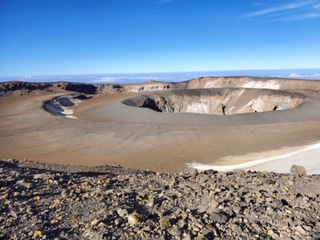Climbing Kilimanjaro Exclusive Packages
Climbing Kilimanjaro Packages by Routes
KILIMANJARO ASH PIT HIKE
KILIMANJARO ASH PIT HIKE: THE CENTER OF THE VOLCANO
The Kilimanjaro Ash Pit is a fascinating and unique geological feature located within the Reusch Crater on Mount Kilimanjaro. Here’s a comprehensive overview of what you need to know about the Ash Pit, the hike to reach it, and the logistics involved:
What is the Kilimanjaro Ash Pit?
Location: The Ash Pit is situated within the Reusch Crater, which is nested inside the larger Kibo Crater on Mount Kilimanjaro.
Formation: It was formed during the last volcanic activity on Kilimanjaro, approximately 200 years ago. The Ash Pit is a symmetrical inverted cone of ash, measuring about 140 meters wide and 350 meters (1,150 feet) deep.
Geological Significance: The Ash Pit is a testament to Kilimanjaro’s volcanic history. It is composed of shale and large boulders, with fumaroles (vents emitting sulfur and steam) at its base. The temperature of these vents is estimated to be as hot as boiling water.
Why Visit the Ash Pit?
Unique Experience: The Ash Pit offers a rare glimpse into Kilimanjaro’s volcanic past. The strong smell of sulfur adds to the otherworldly experience.
Challenging Adventure: Reaching the Ash Pit requires a high level of fitness and acclimatization, making it a rewarding challenge for experienced climbers.
How to Get to the Ash Pit
Starting Point: The hike to the Ash Pit typically begins from Crater Camp, which is located at an altitude of over 18,000 feet.
Route: From Crater Camp, climbers hike across the crater floor, past glaciers, and up the ridge of the Reusch Crater to reach the Ash Pit. The hike takes about 30-40 minutes.
Access to Crater Camp: Crater Camp can be accessed via the Western Breach or by hiking from Barafu Camp to Stella Point.
Acclimatization and Safety
Acclimatization: Spending a night at Crater Camp requires excellent acclimatization. High-altitude sickness is a significant risk, and climbers must be in good health.
Safety Measures: It’s crucial to have a guide experienced in high-altitude first response. Equipment such as Portable Altitude Chambers (Gamow bags) and oxygen canisters are recommended.
Evacuation: Evacuation from Crater Camp is challenging due to the high altitude and remote location. Climbers should be prepared for the possibility of descending quickly if necessary.
Best Routes for a Night at Crater Camp
Lemosho Route: Known for its good acclimatization schedule, this route is often recommended for those planning to spend a night at Crater Camp.
Umbwe Route: A more challenging option, suitable for very experienced climbers. Extra days should be added for better acclimatization.
Machame Route: Some operators offer a night at Crater Camp on this route, but it’s less common.
Logistics and Costs
Special Permits: A special permit is required for Crater Camp, and additional fees are charged for each staff member who stays overnight.
Private Toilet Tents: These are required for the staff staying at Crater Camp.
Costs: The supplement for a night at Crater Camp varies depending on the number of climbers. For example, the cost per person can range from
318 to 606, and a Gamow Bag rental is an additional $300 per trek.




